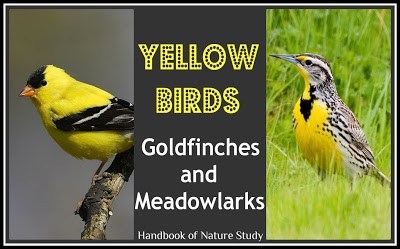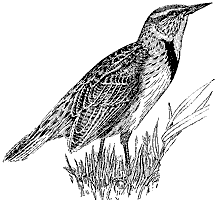
Outdoor Hour Challenge Birds #3
Goldfinch and Meadowlark (Western and Eastern)
Inside preparation work:
1. Read the Handbook of Nature Study pages 29-33 about feathers. Another great link is found here: Feather Structure. Here is another link to Bird Wing Shapes.
2. Read in the Handbook of Nature Study pages 53-57 about the goldfinch.

3. Read the Handbook of Nature Study pages 80-82 about the meadowlark.
4. Backyard Birds: Read aloud with your child pages 16-19. Use the illustrations to point out the field marks for each bird and for the goldfinch, the differences between the male and female birds.
5. Peterson Field Guide: Make note of the wing and tail shape illustrations on pages 18 and 19(W) 24 and 25(E) Look up in the index the goldfinch and the meadowlark. Observe the illustrations carefully and read the narrative descriptions and explanations. Notice the beak, the tail, and the wing shape for future reference. (See links at the bottom of the post for the particulars on these field guides.)
Outdoor Hour Time
Practice your quiet observation skills for at least part of your 10-15 minutes of birding time. Remember the focus from challenge two and make special note of the shape of the beak and the way the bird uses it. Also, make note of the wing and tail shapes of any birds that you observe during this challenge.
Shape of the tail: Square tip? Rounded? Pointed? Notched?
Shape of the wing: Rounded? Pointed? Slim? Long? Short?
Sometimes a bird’s wings and tail look differently when they fly. Observe a bird during flight to see if you can notice different colors, shapes, or stripes when they fly. Remember to make these observations for any bird you see during your outdoor time and not just for the meadowlark and/or the goldfinch.
Follow Up Activity for the Goldfinch and the Meadowlark
You can make a nature journal entry for the goldfinch and the meadowlark if you would like. There are several styles of journal pages in the NotebookingPages.com set below.
You will find a coloring page for the goldfinch in Feeder Birds Coloring Book.
For something different in your nature journal, copy the John Keats poem on page 57 of the Handbook of Nature Study. Many families like to include poetry in their nature journals and this poem about the goldfinch is a perfect addition.
If you are using NotebookingPages.com’s bird nature study set (shown below), you can use the pages on feathers to record your feather observations or you can draw a feather and label its parts.
If you would like to hear the bird calls for this week’s birds, here are the links:
Also I am highly recommending that you purchase the Bird Bundle from NotebookingPages.com as a great supplement to your study of birds using the Outdoor Hour Challenge. Note: These are affiliate links.


Use code discount5 to save $5 on any purchase $10 or more from the NotebookingPages.com Shop. (This does not include membership purchases.)








